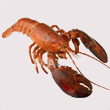Monday, 25 November 2013
Rhythms, Pain and Consciousness in Invertebrates

This week we’d like to offer you a sort of “seafood cocktail”: links to discussions of three fundamental questions of neurobiology, as investigated using three different kinds of marine invertebrates: lobsters, crabs, and Aplysia (sea slugs).
The first link below is to an article that discusses the many rhythmic activities that can be observed in nervous systems, and in particular in that of the lobster. In neurobiology, invertebrates such as lobsters are commonly used as models, because their nervous systems are so much simpler than our own. Thus, in the stomatogastric nervous system of the lobster, researchers have identified a neural circuit that connects about 30 neurons and can generate two different patterns of rhythmic activity that are intrinsic to this circuit. This finding reminds us, first of all, that even in relatively simple organisms, the nervous system does not just passively wait for stimuli from the outside world, but instead maintains continuous, autonomous activity that will only be modulated by the environment. Second, this finding shows that complex phenomena such as circadian cycles or locomotion in humans can be better understood in light of the simpler rhythmic pattern generators found in invertebrates.
The second link below is to an article that addresses the delicate question of pain in invertebrates. There is no question that your cat or dog can feel pain, but is the same true of the lobsters and crabs that you see crammed into tanks at the fish store and that are destined to be taken home and boiled alive? Scientists long believed that because invertebrates have no cerebral cortex (a brain area that is associated with pain in humans), they could have only reflexive responses to painful stimuli. But experiments conducted at Queen’s University in Belfast, Northern Ireland, tend to prove that crustaceans such as lobsters do in fact feel pain. The researchers supported their hypothesis with a series of observations made after lobsters had been given electrical shocks, such as that they favoured the part of the body that had received the shocks and that they displayed an elevated level of stress hormones. Thus, the scientific consensus that crustaceans feel no pain is weaker than it once was.
Lastly, the third link below is to a video of a lecture given by Wayne Sossin at the 2012 Summer School on the Evolution and Function of Consciousness held in Montreal in July 2012. This lecture raises a question closely related to the preceding one, but perhaps even harder to answer: do invertebrates such as crustaceans, or the marine mollusc Aplysia used as a model in this lecture, possess consciousness? Obviously, to answer this question, we would have to know what kind of consciousness we are talking about. In this case, we probably do not mean the kind of reflexive consciousness found in humans—the impression of having a self that perceives the things in one’s environment—but rather a form of primary consciousness, or, to paraphrase the title of a famous article, a feeling of “what it is like to be an Aplysia”. As can be clearly seen from the comments that follow the video, the question of consciousness in invertebrates is far from settled.
![]() Captivating Rhythm
Captivating Rhythm
![]() Lobsters and Crabs Feel Pain, Study Shows
Lobsters and Crabs Feel Pain, Study Shows
![]() Wayne Sossin and Aplysia: If We Understand the Cellular Mechanisms Underlying Sensation and Learning, What Do We Need Consciousness For?
Wayne Sossin and Aplysia: If We Understand the Cellular Mechanisms Underlying Sensation and Learning, What Do We Need Consciousness For?
Pleasure and Pain, The Emergence of Consciousness | Comments Closed







